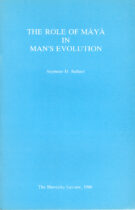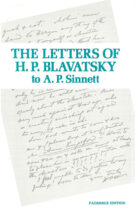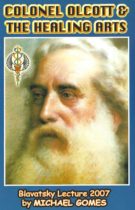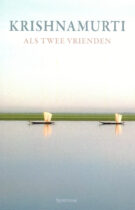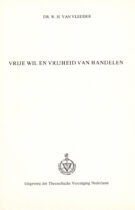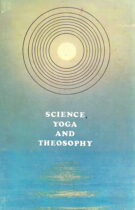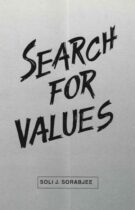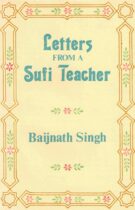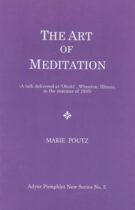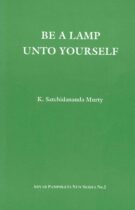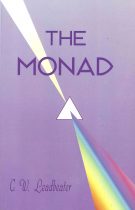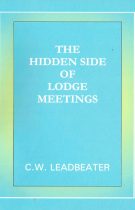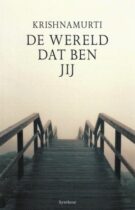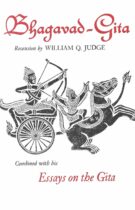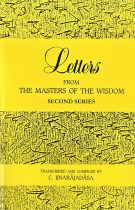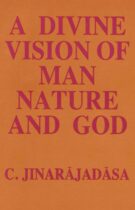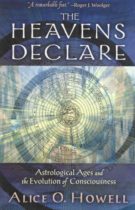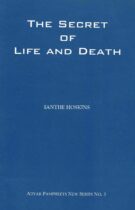The Role of Māyā in Man’s Evolution
19 Pages | Softcover | The Blavatsky Lecture, 1986 | The Theosophical Society in England, London | No ISBN.
The Blavatsky Lecture delivered at the Annual Convention of the Theosophical Society in England at the College of Ripon and York, St. John, Ripon, July 29th, 1986.
A vital feature of the esoteric traditions contains the notion that all manifestation is to be regarded as illusion. Illusion is the usual translation of the Sanskrit word māyā. Yet, although she uses this definition of the Sanskrit Helena Petrovna Blavatsky (1831 – 1891) presents important qualifications to the word to help the student fathom the subject matter in her major work. She writes: ‘Māyā or Illusion, is an element which enters into all finite things, for everything that exists has only a relative, not an absolute, reality, since the appearance which the hidden noumenon assumes for any observer depends upon his power of cognition…’
From page 4:
” Nothing is permanent except the one hidden absolute Existence which contains in itself the noumena of all realities. The existences belonging to every plane of being, up to the highest Dhyan Chohans, are, comparatively, like the shadows cast by a magic lantern on a colourless screen. Nevertheless, all things are relatively real, for the cognizer is also a reflection, and the things cognised are therefore as real to him as himself. Whatever reality things possess, must be looked for in them before or after they have passed like a flash through the material world; for we cannot cognize any such existence directly, so long as we have sense instruments, which bring only material existences into the field of our consciousness. “
Aantekeningen
Door Jiddu Krishnamurti (1895 – 1986), vertaald door Hans van der Kroft, Thecla de Waal en Anneke Korndörffer.
367 Pagina’s | Eerste druk 1981, 2de uitgebreide druk 2004, 3de herziene druk 2018 | Softcover | Synthese, een imprint van Milinda Uitgevers B.V. | ISBN: 9789062711499.
Engels origineel: Krishnamurti’s Notebook | Copyright 1976, 2003 (full text edition) | Krishnamurti Foundation Trust, Ltd., Hampshire, England | ISBN: 9781888004632.
Krishnamurti’s Notebook is geen gewoon dagboek, maar een verzameling persoonlijke notities, die Krishnamurti maakte vanaf 18 juni 1961 tot 23 januari 1962, tijdens zijn reizen en zijn verblijf in Amerika, Engeland, Frankrijk, Zwitserland, Italie en India. Op 323 met de hand geschreven en door hemzelf genummerde pagina’s beschrijft hij in dichterlijk proza de beweging van de wolken, de wind, de bomen, het licht, de vogels en de extatische eenheidsbeleving, die hij in deze natuurverschijnselen ervaart. Meditatie, kun je volgens Krishnamurti niet methodisch opwekken, maar is een explosie van ‘gewaar-zijn’ op het moment, waarop je denken stil is en je de feiten ziet zonder ze te willen veranderen.
Afkomstig van blz. 21:
” Het heilige heeft geen attributen. Een steen in een tempel, een beeld in een kerk, een symbool – ze zijn niet heilig. De mens noemt ze heilig, iets dat gewijd is om te worden aanbeden uit gecompliceerde driften, angsten en verlangens. Die ‘heiligheid’ ligt nog in het vlak van het denken; ze is door het denken opgebouwd en in het denken ligt niets nieuws of heiligs. “
Waarheid is een Land zonder Wegen
Door Jiddu Krishnamurti (1895 – 1986), vertaald door May Verheyen.
175 Pagina’s | Copyright 1954, Nederlandse vertaling 2014 | Softcover | BBNC Uitgevers, Amersfoort | ISBN: 9789045316895.
Engels origineel: On Truth | Published in 1954 | Krishnamurti Foundation of America | ISBN: 978-0062510129.
‘ Religie betekent het onverschrokken verkennen, sceptisch bevragen en onderzoeken wat waarheid is. Dat is religie. – Ojai, 2 mei 1981. ‘
Waarheid is een Land zonder Wegen daagt de lezer uit tot zelfonderzoek en dialoog. Waarom zouden we ons druk maken om wegen, om waarheid om wat anderen zeggen, vraagt Krishnamurti ons in een van de vele diepgaande gesprekken, die dit boek rijk is. Waarom maak je het niet voor jezelf uit? En hoe doe je dat?
Zien wat er feitelijk is, wat zich op dit moment voordoet, is het enige waar het op aankomt, volgens Krishnamurti. Of het nu gaat over economische, sociale, religieuze, politieke of psychische vraagstukken, ontdek wat is – en vergeet wat zou moeten zijn. Ons grote struikelblok is het verlangen naar veiligheid, naar iets wat volmaakt bevredigend is en beklijft. En als er geen veiligheid blijkt te bestaan, houden we onszelf voor dat we op weg zijn naar de waarheid, Terwijl waarheid, zo oppert Krishnamurti, misschien eerder is als in een boot zitten zonder roeispaan – we ontdekken, bewegen, leren, blijven gaande.
Uit: ‘Bombay 12 maart 1950’ (blz. 35):
” Waarheid vind je niet door boeken, vrome toewijding of zelfopoffering: waarheid leer je kennen wanneer de geest vrij en kalm is. En die vrijheid, die kalmte van de geest komt alleen wanneer de feiten van zijn relaties begrepen worden. Zonder dat begrip leidt wat de geest ook doet, alleen maar tot meer problemen. Maar een geest, die vrij is van al zijn projecties kent een staat van kalmte, waarin alle problemen zijn verdwenen, en alleen dan wordt het tijdloze, het eeuwige geboren. Waarheid is dan niet langer een kwestie van kennis, niet iets wat je je moet herinneren of wat je moet herhalen, niet iets om te laten drukken en in het buitenland te verspreiden. Waarheid is dat wat ‘is’. Waarheid heeft geen naam en daarom heeft de geest er geen toegang. “
Beyond the Postmodern Mind – The Place of Meaning in a Global Civilization (2003 edition)
By Huston Smith (1919- 2016).
295 Pages | First Quest Edition 1984, 2nd edition 1989, 3rd printing 1992, 3rd edition 2003 | Softcover | Quest Books, U.S.A. | ISBN: 0835608301.
NB: This is the latest and third edition: the second, hence cheaper edition of this book can be purchased in our Webshop here.
This study was first published in 1982 and is considered a classic in its disciplined analysis of contemporary reductionist philosophy. It explores the limits of science and points society’s way out of the dark woods where science has stranded us. Smith uses the term ‘modern’ mind to denote the so-called Enlightenment outlook of Newtonian physics and rationalism, which cut the ground from under the religious foundations of Western life. In the ‘post-modern’ age of the late nineteenth and the twentieth centuries, people lost their humanistic confidence.
Although science may have won a battle ove religion, it has in the process undermined its own empirical foundation: and having destroyed confidence in intuitive revelation, the mind is (as H.G. Wells once suggested) ‘at the end of its tether’. Despite the ravages of analytical philosophy and existentialism, Smith feels there is a fundamental view of reality, that flourishes throughout the world under various disguises. The uneasy post-modern mind, Smith says, awaits discernment of a new metaphysics.
From Chapter 3 – ‘Perennial Philosophy, Primordial Philosophy’ (p. 64):
” A life, that identifies primarily with its physical pleasures and needs (getting and spending we lay waste our days) is superficial;
one that advances its attention to the mind can be interesting if it moves on to the heart (synonym for soul), it can be good.
And if it passes on to spirit – that saving self-forgetfulness and egalitarianism in which one’s personal interests loom no larger than those of others – it would be perfect. “
Joyful Gnosis: Gnostic Light on Blavatsky’s Wisdom
25 Pages | Sunday July 27th, 2003 | Softcover | Theosophical Publishing House, London | No ISBN.
The Blavatsky Lecture delivered at the Summer School of The Theosophical Society in England, the University of Loughborough.
An exploration of Helena Petrovna Blavatsky’s (1831 – 1891) teachings in the light of the embodiment of the Ancient Wisdom known as Gnosticism. The title of this lecture alludes to three specific topics:
- The teachings of the foundress and principal teacher of what has been called Modern Theosophy.
- The earlier embodiment of the Ancient Wisdom Tradition known as Gnosticism.
- The character of this same Wisdom tradition described here as ‘joyful Gnosis’.
From page 5:
” Gnosticism is the teaching based on Gnosis, the knowledge of transcendence arrived at by way of interior, intuitive means. Although Gnosticism thus rests on personal religious experience, it is a mistake to assume all such experience results in Gnostic recognitions. It is nearer the truth to say that Gnosticism expresses a specific religious experience, an experience that does not lend itself to the language of theology or philosophy, but which is instead closely affinitized to, and expresses itself through, the medium of myth. Indeed, one finds that most Gnostic scriptures take the forms of myths. The term ‘myth’ should not be taken to mean ‘stories that are not true’, but rather, that the truths embodied in these myths are of a different order from the dogmas of theology or the statements of philosophy. “
CWL Speaks – C.W. Leadbeater’s Correspondence concerning the 1906 Crisis in the Theosophical Society
By Charles Webster Leadbeater (1854 – 1934), compiled by Pedro Oliveira with a Foreword by Robert Ellwood.
316 Pages | Second printing 2018 | Paperback | Olive Tree Publishing ISBN: 9780646973050.
Charles Webster Leadbeater (1854 – 1934) joined the Theosophical Society in 1883 in London and travelled with H.P. Blavatsky (1831 – 1891) to India in 1884. He helped Col. Henry S. Olcott () in his work for Buddhist education in Ceylon, now Sri Lanka. While at the Headquarters of the Theosophical Society at Adyar, Madras, in India, he was taught some meditation exercises by one of Madame Blavatsky’s spiritual Teachers, who had accepted him as a Chela (disciple), in 1884. The exercises helped him to develop the faculty of clairvoyance.
From 1900 to 1905 he was a popular international lecturer for the TS, concentrating his visits to the United States. Some American families wanted their sons to accompany him in his travels to be trained in Theosophical work by him. In 1906, he was charged by the leadership of the American Section of the TS with giving sexual education to some boys under his care. Something still taboo in those days, but nowadays considered to be part of a normal curriculum. Following an enquiry in London, presided over by Col. Olcott, he resigned his membership of the Society.
For many, the episodes of 1906 sealed his image as an immoral man, although he was never charged or prosecuted in any country. He never defended himself of the accusations. After 110 years, all his relevant correspondence regarding that crisis is gathered together in this book. For the first time, his full thoughts and views about those events are presented to the public. Here, CWL speaks.
From page 274:
” One evening, Mr. Leadbeater, on our return to his room after our swim, told me that one of the boys had a remarkable aura. I asked which one, and he said it was the boy named Krishnamurti. I was surprised, for I already knew the boys, as they had been coming to me and to Subramanyam in the evenings to help in connection with their school home work, and it was evident that Krishnamurti was not one of the bright students. Then Mr. Leadbeater told me that Krishnamurti would become a great spiritual leader and a great speaker. I asked, ‘How great?’ As great as Mrs. Besant’? He replied, ‘Much greater’. And shortly after that he said that Krishnamurti would be the vehicle for the Lord Maitreya, the coming Teacher, who inspired Jesus. He was directed to help in training the boy for that purpose, which would be fulfilled, he told me, ‘unless something goes wrong’. This, I want to emphasize, in justice to Mr. Leadbeater. ” (Ernest Wood)
Sikhism
By Annie Besant (1847 – 1933).
47 Pages | First edition 1963, third edition 2005 | Paperback | Theosophical Publishing House, Adyar | ISBN: 8170594677.
Annie Besant (1847 – 1933), second President of the Theosophical Society (1907 – 1933) was described as a ‘Diamond Soul’, for she had many brilliant facets to her character. She was an outstanding orator of her time, a champion of human freedom, educationist, philanthropist and author with more than three hundred books and pamphlets to her credit. She also guided thousands of men and women all over the world in their spiritual quest.
In 1896, Dr. Annie Besant gave four Convention Lectures on Hinduism, Zoroastrianism, Buddhism and Chrisitianity at Adyar, Madras, on the twenty-first anniversary of the Theosophical Society, the President-Founder, Colonel Henry Steel Olcott (1832 – 1907), being in the Chair. In 1901, she continued the series with another four lectures on Islam, Jainism, Sikhism and Theosophy or ‘Divine Wisdom’ as the common source of all religions at the twenty-sixth anniversary, Colonel Olcott again presiding. Each of the lectures on the seven religions has been published as a separate booklet with the exception of the lecture on Divine Wisdom, and the whole series as a single volume under the title Seven Great Religions.
From page 1/2:
” Most people in thinking of the Sikh think of a gallant warrior, a brave soldier. But we shall err seriously if we look on him as only, or even as fundamentally a fighter. The movement itself is fundamentally a religious one. It grew up in the midst of Hinduism, having for its ideal the joining together of the Hindus and the Muslims in one league of love to God and service to man. The thought of its founder, Guru Nānak, as we find it expressed not only in his words, but far more in his life, was to join together these warring elements of the Indian people on a platform, that both could accept. “
Jainism
By Annie Besant (1847 – 1933).
21 Pages | First edition 1949, second edition 2005 | Paperback | Theosophical Publishing House, Adyar | ISBN: 8170594707.
Annie Besant (1847 – 1933), second President of the Theosophical Society (1907 – 1933) was described as a ‘Diamond Soul’, for she had many brilliant facets to her character. She was an outstanding orator of her time, a champion of human freedom, educationist, philanthropist and author with more than three hundred books and pamphlets to her credit. She also guided thousands of men and women all over the world in their spiritual quest.
In 1896, Dr. Annie Besant gave four Convention Lectures on Hinduism, Zoroastrianism, Buddhism and Chrisitianity at Adyar, Madras, on the twenty-first anniversary of the Theosophical Society, the President-Founder, Colonel Henry Steel Olcott (1832 – 1907), being in the Chair. In 1901, she continued the series with another four lectures on Islam, Jainism, Sikhism and Theosophy or ‘Divine Wisdom’ as the common source of all religions at the twenty-sixth anniversary, Colonel Olcott again presiding. Each of the lectures on the seven religions has been published as a separate booklet with the exception of the lecture on Divine Wisdom, and the whole series as a single volume under the title Seven Great Religions.
From page 1/2:
” One might almost sum up Jainism in a phrase, that we find in the Sutra Kritānga, that man by injuring no living creature reaches the Nirvāna, which is peace. That is a phrase, that seems to carry with it the whole of this religion – peace: peace between man and man, peace between man and animal, peace everywhere and in all things, a perfect Brotherhood of all that lives. Such is the ideal of the Jain, that he endeavours to realize upon earth. “
Hinduism
By Annie Besant (1847 – 1933).
45 Pages | First edition 1963, third edition 2005 | Paperback | Theosophical Publishing House, Adyar | ISBN: 8170594650.
Annie Besant (1847 – 1933), second President of the Theosophical Society (1907 – 1933) was described as a ‘Diamond Soul’, for she had many brilliant facets to her character. She was an outstanding orator of her time, a champion of human freedom, educationist, philanthropist and author with more than three hundred books and pamphlets to her credit. She also guided thousands of men and women all over the world in their spiritual quest.
In 1896, Dr. Annie Besant gave four Convention Lectures on Hinduism, Zoroastrianism, Buddhism and Chrisitianity at Adyar, Madras, on the twenty-first anniversary of the Theosophical Society, the President-Founder, Colonel Henry Steel Olcott (1832 – 1907), being in the Chair. In 1901, she continued the series with another four lectures on Islam, Jainism, Sikhism and Theosophy or ‘Divine Wisdom’ as the common source of all religions at the twenty-sixth anniversary, Colonel Olcott again presiding. Each of the lectures on the seven religions has been published as a separate booklet with the exception of the lecture on Divine Wisdom, and the whole series as a single volume under the title Seven Great Religions.
From page 44/45:
” Thus universe succeeds universe, each aiding its successors until our thought fails to express itself, and the human faculty sinks down unable to soar further. Such, most imperfectly expressed, is the religion founded in immemorial antiquity, that has come down from the rshi-s. Such ought to be your religion, heirs of the past, descendants of those mighty ones! Just in so far as you live it, in so far are your really their heirs. Just in so far as this is dear to you and practised by you, are you learning the lesson of evolution as it was taught by them, and given to the people they instructed. Just so far are you profiting by opportunities greater than those offered to any other nation, opportunities that, wasted, will be bewailed by you under less favourable conditions in many a life to come. “
The Letters of H.P. Blavatsky to A.P. Sinnett
By Helena Petrovna Blavatsky (1831 – 1891) with an introduction by A. Trevor Barker.
404 Pages | First published in 1925, 1973 facsimile edition | Hardcover | Theosophical University Press, Pasadena, California | ISBN: 9780911500233.
There are several references to the writing of The Secret Doctrine, which show to how great an extent the Masters were themselves responsible for that work. That is why the teaching of H.P.B. ‘remains for us the test and criterion of Theosophy, ‘ by which all other teaching on the subject must be judged.
From the Introduction (p. ix):
” After all, if the Masters do not know what Theosophy is, no one does, because in its essence, purity and completeness it is alone contained in the secret teaching of which the Guardians are the Masters Themselves. That teaching, as stated by H.P.B., ‘ is not the fancy of one of or several isolated individuals, but the fruit of work of thousands of generations of Adept Seers, ’through who it was handed down from the first Divine Instructors of our Humanity. It is the substratum and basis of all the world-religions and philosophies, but its doctrines are the exclusive possession of none of them. It was the mission of Madame Blavatsky, under the instructions of those Adepts, to give to the world selected portions of that archaic teaching. It should be remembered that an Adept – a Master, is one who has achieved immortality, and therefore has the power to perceive Truth as it is and at will to reflect it without distortion. “
Madame Blavatsky and Soobiah
By an anonymous author.
22 Pages | Published during the International Convention 1991 | Booklet | The Theosophical Publishing House, Adyar | ISBN:
SOOBIAH CHETTY’S REMINISCENCES OF MADAME H.P. BLAVATSKY
When Helena Petrovna Blavatsky (1831 – 1891) and Henry Steel Olcott (1832 – 1907) visited Madras in 1882 and lectured in the Georgetown area, Grandhi Muthuswami Chetty who was a judge, listened to them. Though he was a rich man, he was spiritually dissatisfied, and though a Hindu desired to be converted to another religion. Muthuswami’s enquiring mind was kindled by the two foreign lecturers. He wrote down several questions about whether he should opt for another religion and left those papers in a cupboard in his house before he went to sleep in the night. Next morning, when he woke up and looked in the cupboard, to his amazement he found that all his questions had been answered. Muthuswami was convinced by the answers and never became a convert, for he joined the Theosophical Society.
From page 18:
” Good bye dearest Soobhiya & may the Masters bless and protect you. If you do come it will be the happiest day I will have had in these three years of exile! . . . I hope your dear wife and children are all well. Give them my blessing if they accept it.
Yours ever affectionately,
H.P. Blavatsky
I send you my Lucifer, Love to all friends – if there are any left.
H.P.B. “
The Multitudinous Universe – Blavatsky Lecture 2017
25 Pages | Blavatsky Lecture 2017 | Soft cover | The Theosophical Publishing House, London | No ISBN.
‘The Blavatsky Lecture’ is one of the most prestigious presentations in the Theosophical Society. Partly, because of its longevity, continuity, subject matter, the eminence of its presenters, and the fact that for hundred years these lectures have been available as separate publications, the Blavatsky Lecture has achieved a unique position among Theosophical talks. It is the equivalent of the Academy Awards of Theosophy.
From page 20:
” One of the enduring benefits of Theosophy is that it is practical. Certainly, its teachings are filled with high ideas and often difficult concepts that challenge our thinking. How can the teachings on rounds, races, manvantara, dhyani chohans, sevenfold planes of being, etc. be claimed as ‘practical’? One way that H.P Blavatsky described Theosophy was, the accumulated Wisdom of the ages tested and verified by generations of seers, To the mentally lazy or obtuse it will always remain a riddle. The Wisdom is constant and unchanging, and has been accessible throughout the ages to those, who approach it properly. From the beginning one of the demands has been that the mental principle becomes consciously active. “
The Path of Transformation – Voyage to the Silent Self
By Susan Bayliss.
35 Pages | Softcover | Blavatsky Lecture 2014 | The Theosophical Publishing House, London | No ISBN.
Life is full of potentiality from ’the circle of heaven’ to Mother Earth and all that live within her. The extent of this potential is hidden from us in our mundane world, concealed, according to the ‘Ancients’, behind a veil of illusion in which we live and experience our everyday lives. Out of nothingness came the ‘Great Illusion’ into a state of potentiality awaiting the impulse to become an expression of new life – a new universe. The same potentiality also lies within us and we too can awaken to a ‘new world’; a world in which we are transformed from a place of ignorance to a state of Knowledge and Wisdom. Our taks is to find the keys which open the the doorway to the higher life. Helena Petrovna Blavatsky (1831 – 1891) (HPB) in the Secret Doctrine (SD) describes the process of Life awakening at cosmic level, from potential space to the abstract space of ‘divine immaculate Mother-Nature’.
From page 29:
” In The Key to Philosophy, Helena Petrovna Blavatsky (1831 – 1891) tells us that the final goal cannot be reached in any way but through life experiences, and because most of this consists of pain and suffering, this is how we learn. Many of us will have seen the photograph of Einstein sittings at his desk with a copy of The Secret Doctrine lying there along with other books. He famously said that ‘The intellect has little to do on the road of discovery. There comes a leap in consciousness, call it intuition or what you will, and the solution comes to you and you don’t know how or why. All great discoveries are made in this way. “
H.P. Blavatsky the Light-Bringer – The Blavatsky Lecture 1970
By Geoffrey A. Barborka.
67 Pages | Blavatsky Lecture 1970 | Softcover | The Theosophical Publishing House, London. | No ISBN.
This Lecture commemorates the coming to the Western world of one who was the representative of a great Brotherhood – a Brotherhood which is known by many names. One of its epiphets, especially in connection with its origin, is a symbolic one; the Sons of Ad or Sons of Fire-Mist. Little has been written about these Sons. However, the meaning associated with the term is clear enough; for it links up with the name given to those Divine Beings who came to the assistance of humanity during one of its most critical periods. These are the Agnishvatta Pitris, the awakeners of the fire – which signifies the Mind-principle.
Geoffrey A. Barborka (1897 – 1982) was brought up at Point Loma, California. He had a classical education to which were added modern languages / German, French and Spanish+ and these were later supplemented by a study of Hebrew and Sanskrit. He is the author of a number of books, including The Divine Plan, H.P. Blavatsky, Tibet and Tulku and The Pearl of the Orient.
Colonel Olcott and the Healing Arts – Blavatsky Lecture 2007
49 Pages | Blavatsky Lecture 2007 | Softcover | The Theosophical Publishing House, London | No ISBN.
On August 29, 1882, Colonel Henry Steel Olcott (1832 – 1907), President-Founder of the Theosophical Society, was in Galle, Ceylon, on a lecturing tour to raise funds for the opening of the schools for Buddhist children. One of the people who came forward to contribute was a man, whose arm and leg had been paralyzed for eight years. Olcott, who had read the literature on animal magnetism, or mesmerism as it was also termed, and magnetic healing in his youth, says he was moved to try some healing passes with his hands over the man’s arm, telling him that he hoped he might feel better.
Later that evening the gentleman returned to thank the Colonel, saying indeed his condition had improved. This encouraged Olcott to treat the arm again. There was a marked improvement when he returned the next morning, and, after two more days of treatment, he could move his arm and open and close his hand. Olcott also tried working on the man’s leg, which responded well enough to allow his to walk freely and even run. To show his thanks, the now-healed man brought a friend, who was also paralyzed. When he was cured, others came in increasing numbers, to the point, the Colonel recalled, ‘within a week or so my house was besieged by sick persons from dawn until late night, all clamoring for the laying on of my hands’.
Within the space of a year, he would treat some 8.000 people, until, at the verge of his own health breaking down, he was ordered by his teacher to stop. This little-known episode in the work undertaken by Olcott offers and instructive glimpse into the revival of alternative healing that was occuring at the time and which has now entered the mainstream.
Pyramids and Stonehenge
By Alfred Percy Sinnett (1840 – 1921).
27 Pages | Softcover | First published in 1893, 3rd edition 1958, reprinted 1970 | Henry Ling Limited, The Dorset Press, Dorchester, Dorset | ISBN: 722952503.
Two lectures delivered before The Theosophical Society, London, in 1892-93 and now reprinted in 1958 in respose to repeated requests arising out of modern interest in the Pyramids, Stonehenge and also Atlantis. Their value is felt to lie in the text as originally given, and no attempt has therefore been made to revise them.
The Doctrine of the Heart – Extracts from Letters of Indian Friends to Annie Besant, with her Foreword
By Annie Besant (1847 – 1933).
87 Pages | First edition, 5th reprint, 2011 | Softcover | Theosophical Publishing House, Adyar | ISBN: 9788170594406.
” VERILY THOSE WHO HAVE EYES TO SEE MAY SEE, AND THOSE WHO HAVE EARS TO HEAR MAY HEAR “.
This series of papers consist chiefly of extracts from letters received by from Indian friends. They contain thoughts that have been found helpful, and hence worth sharing with others. They are intended for those, who seek to learn to separate head-learning from ‘Soul-Wisdom’ and to live the higher life.
Mahābhārata – The Story of the Great War
By Annie Besant (1847 – 1933).
305 Pages | 7th Reprint, 2017 | Softcover | The Theosophical Publishing House, Adyar | ISBN: 9788170591832.
Mahābhārata is ‘one of the greatest books in the world‘ says Annie Besant (1847 – 1933), eminent scholar of Hinduïsm as well as Comparative Religion, and International President of the Theosophical Society (1907 – 1933), in the introduction to this book. It is the story of the Aryan race in India some 5.000 years ago and includes an account of the epic war between the Pandavas and Kauravas.
This book is based on notes of lectures delivered by Besant at the Central Hindu College Beneras (now Varanasi) in the first decade of this century. She describes the Mahābhārata as a great teacher of Ethics and Philosophy, an it is also history. The original Sanskrit verse, she says, ‘is the greatest poem in the world’.
Als Twee Vrienden (Talks Amsterdam 1981)
Door Jiddu Krishnamurti (1895 – 1986), vertaald door H.W. Methorst, herzien door Hans van der Kroft.
66 Pagina’s | Eerste druk 1981, 5de druk 2014 | Softcover | Synthese Uitgevers, Rotterdam | ISBN: 9789062710768.
In het najaar van 1981 kwam Krishnamurti, na ruim tien jaar niet in Nederland te zijn geweest, nog een keer naar Amsterdam. Hij trok, zoals gebruikelijk, een indrukwekkende schare van belangstellenden en al enkele weken later verscheen de vertaalde tekst van zijn twee toespraken in druk. Deze nieuwe uitgave van die tekst zal duidelijk maken, dat Krishnamurti ook in de eindfase van zijn leven niets aan zeggingskracht had verloren.
‘Waarom zijn wij mensen er niet in geslaagd het probleem van menselijke relaties tot een bevredigende oplossing te brengen?’ is een van de eerste vragen waarmee Krishnamurti deze twee toespraken in Amsterdam begon. En vervolgens gaf hij een pakkend en bondig overzicht van de ontzaglijke dreiging van de economisch-politieke crises, de geweldige ontplooiing van het denken in technische zin – terwijl juist het denken de problemen, die het zou willen oplossen zelf geschapen heeft – en van kwesties van liefde en van dood. ‘Meditatie’, zei hij, ‘is niet een methode om iets te verkrijgen of iets te bereiken; meditatie is orde scheppen in ons leven door af te rekenen met tegenstrijdigheden’.
Afkomstig uit Toespraak I (p. 17):
” We hebben dus allemaal dezelfde basis, ons bewustzijn. Dat bewustzijn hebben we allemaal met elkaar gemeen. Daarom zijn we ook geen individuele mensen. Denk daar eens goed over na! We zijn er zowel op school als door de godsdienst in getraind en toe opgevoed te geloven dat wij individuele mensen zijn, afzonderlijke zielen, die ieder voor zich iets nastreven. Maar dat is een waanidee, want ons bewustzijn hebben we met heel de mensheid gemeen. Daarom zijn wij de mensheid. We zijn geen afzonderlijke, voor zichzelf opkomende individuele mensen. Dat is een kwestie van redelijkheid, van logica, van gezond verstand. We zijn geen afzonderlijke wezens met een eigen, afzonderlijke psychische inhoud, die om het eigen bestaan worstelen. Nee, ieder van ons is werkelijk de rest van de mensheid. “
Maar Krishnamurti was wel een vriend die zijn gesprekspartners onomwonden de waarheid zei. Niet ten onrechte werd hij wel aangeduid als de belangrijkste beeldenstormer van de twintigste eeuw. De beelden die hij bestormde zijn de naar zijn inzicht verstarde denkbeelden en meningen waarmee de mens zich heeft verschanst in een burcht van beperkende regels en systemen, die er vooral op gericht zijn het eigenbelang veilig te stellen.
The Self and Its Problems
By Charlotte W. Woods.
182 Pages | The Blavatsky Lecture for 1919 | Photo copy (1992) from the first edition published by The Theosophical Publishing House, London in 1922 | Kessinger Publishing Company, Montana U.S.A. | ISBN: 1564592642.
CONTENTS:
1. The Problem of the Self from Descartes to Kant.
2. The Problem of the Self in Current Philosophy.
3. The Problem of the Self in Theosophic Mysticism.
4. An Examination of the Forgoing Standpoints.
5. Conclusion.
From Chapter 4: ‘An Examination of the Forgoing Standpoints’:
” We have thus arrived at a definition of the self in our philosophy; it is the ground and condition of the manifold of experience, the unity, purpose, and wholeness, which give meaning to bare multiplicity and stability to that which is mobile and changing . . . “
Vrije Wil en Vrijheid van Handelen
Door Dr. W.H. van Vledder.
27 Pagina’s | Uitgegeven in 1981 | Lecture | Uitgeverij der Theosofische Vereniging in Nederland, Utrecht | Geen ISBN.
De publicatie betreft de inhoud van een Rede uitgesproken bij het aanvaarden van het ambt van bijzonder hoogleraar in de metafysica in de geest van de Theosofie aan de Rijksuniversiteit te Leiden op vrijdag 3 april 1981.
Afkomstig van pagina 21:
” We kunnen het probleem van de vrije wil en de vrijheid van handelen nu ook als volgt benaderen. Uitgaande van de mens levend in wat wij het veld van openbaring hebben genoemd, zien wij de mens gebonden door zijn gericht zijn op al wat hem omringt. Wij hebben dat een horizontale relatie genoemd. De moeilijkheid is nu hierin gelegen, dat de mens zijn aandacht naar buiten richt, dat hij vraagt om meer ruimte voor zichzelf, waardoor een steeds grotere afgescheidenheid onstaat. die – paradoxaal – zijn wezenlijke vrijheid belemmert. Afgescheidenheid, begeerte naar vrijheid en ik-gerichtheid zijn omgekeerd evenredig met de wezenlijke, innerlijke geestelijk gerichte vrijheid. De naar buiten gerichte mens is zich daar echter niet van bewust. “
The Absolute – The Ultimate Reality (Parabrahman) (Blavatsky Lecture 1985)
By Harry Upadhyay, Ph.D.
32 Pages | 27 July 1985| Softcover | The Theosophical Society in England, London | No ISBN.
The Blavatsky Lecture delivered at the Annual Convention of The Theosophical Society in England at the University of Nottingham, 27 July 1985.
‘ADRISHTAM, AVYAVAHARYAM, AGRĀHYAM, ALAKSHNAM, ACHINTYAM, AVYAPADESHYAM’
‘Unperceivable, beyond empirical dealings, beyond grasp of the organs of action, uninferable, unthinkable, indescribable . . . ‘ – Māndukya Upanishad.
These words of the Māndukya Upanishad are not the only significant references to the Absolute, the Ultimate Reality; Parabrahman. Such words about Brahman and Ātman abound in most of the Upanishads. I quote here just a few. Maitri Upanishad says – ‘The Spirit Supreme is immeasurable, inapprehensible, beyond conception, never-born, beyond reasoning, beyond thought.’ Mundaka Upanishad says – ‘He cannot be reached by the senses, or by an austerity or sacred action . . . ‘
Psychism and the Unconscious Mind
Edited by H. Tudor Edmunds.
254 Pages | First Quest edition 1968, second edition 1974 | Softcover | Quest Books, USA | ISBN: 0835604128.
Collected Articles from the Science Group of the Theosophical Research Centre, London.
This book is the result of research and study by a group of distinguished British scientists, who have devoted much time and applied the training in their various disciplines to an unprejudiced investigation of the many areas of psychic manifestation. Their comments and discussions on such subjects as telepathy, clairvoyance, hypnosis, and effects of mindexpanding drugs, the human aura, and related subjects, are perceptive and informative. Because the writers are also students of Theosophy and Eastern philosophy, they have been able to add valuable insights to their considerations of the various phenomena without in any way lessening their objective and scientific approach to this still mysterious field of human experience.
From Chapter: ‘The Interior Organ of Perception (p.55):
Mind is the inner organ.
” So whether approached from within by the Eastern metaphysical insight or from without by an attempt to deduce an hypothesis to explain scientific observations, it would appear, that man’s mind is an inner organ, or instrument, of perception with a focus of ‘I-ness’ associated with the brain. It has the capacity of throwing up a three-dimensional field of imagined images, thoughts and feelings, themselves not spatial in a physical sense, but related to space by some method of direct correlation. They appear in a mental field, which is not the property of any one observer, but can only be termed a generalised mental field. “
Science, Yoga and Theosophy
By several authors.
262 Pages | Published in 1977 | Hardcover | Theosophical Publishing House, Adyar | ISBN: 835675300.
The Theosophical Society was formed at New York, November 17, 1875, and incorporated in Madras, India, April 3, 1905. The three declared Objects are:
1. To form a nucleus of the Universal Brotherhood of Humanity, without distinction of race, creed, sex, caste or colour.
2. To encourage the study of comparative religion, philosophy and science.
3. To investigate unexplained laws of nature and the powers latent in man.
From the Chapter ‘Scientific Alchemy – The Physics of a New Age’ (p. 9):
” Plato’s dream of the philosopher-king is perhaps realizing its most practical actualization in the new physics: the union of the philosopher-scientist. The scientific method of the new physics is encompassing an imaginative wholeness, an indeterministic openness, that might best be conveyed by the language of poetry and philosophy, by the TAO. There is no dichotomy here between science and poetry; equation and verse together become a symbol for an expression of the reality of the universe. “
Search for Values
19 Pages | Besant Lecture delivered at Adyar, Dec. 1992, first published in 1995 | Booklet | Theosophical Publishing House, Adyar | ISBN: 8170592623.
The moral worth of a society or a community is reflected in its aspirations and the ideals it pursues, the values it cherishes and its sincerity in upholding those values, Throughout history, humanity’s chief concern has been the disovery and preservation of values, which impart grace and significance to civilization and also to individual human lives. One of the cruellest paradoxes of our times is that an age that has witnessed tremendous scientific progress and technological development has at the same time also witnessed unprecedented decline in moral and spiritual values.
From page 17:
” If I can stop one heart from breaking
I shall not live in vain
If I can ease one life the aching or cool one pain
Or help one fainting robin unto its nest again
I shall not live in vain. “
Beyond the Postmodern Mind – The Place of Meaning in a Global Civilization (1989 edition)
By Huston Smith. (1919- 2016).
281 Pages | First Quest Edition 1984, 2nd edition 1989, 3rd printing 1992. | Softcover | Quest Books, U.S.A. | ISBN: 0835606473.
NB: This is the second edition (1989): its latest and third edition (2003) can be purchased in our Webshop here.
This study was first published in 1982 and is considered a classic in its disciplined analysis of contemporary reductionist philosophy. It explores the limits of science and points society’s way out of the dark woods where science has stranded us. Smith uses the term ‘modern’ mind to denote the so-called Enlightenment outlook of Newtonian physics and rationalism, which cut the ground from under the religious foundations of Western life. In the ‘post-modern’ age of the late nineteenth and the twentieth centuries, people lost their humanistic confidence.
Although science may have won a battle ove religion, it has in the process undermined its own empirical foundation: and having destroyed confidence in intuitive revelation, the mind is (as H.G. Wells once suggested) ‘at the end of its tether’. Despite the ravages of analytical philosophy and existentialism, Smith feels there is a fundamental view of reality, that flourishes throughout the world under various disguises. The uneasy post-modern mind, Smith says, awaits discernment of a new metaphysics.
From Chapter 3 – ‘Perennial Philosophy, Primordial Philosophy’ (p. 70):
” A life, that identifies primarily with its physical pleasures and needs (getting and spending we lay waste our days) is superficial;
one that advances its attention to the mind can be interesting if it moves on to the heart (synonym for soul), it can be good.
And if it passes on to spirit – that saving self-forgetfulness and egalitarianism in which one’s personal interests loom no larger than those of others – it would be perfect. “
Letters from a Sufi Teacher
By Baijnath Singh.
97 Pages | First edition 1908, revised edition 1987 | Softcover | Theosophical Publishing House, Adyar | ISBN: 8170590450.
A teacher is in reality the inner being by the side of God, in the region of Truth, clothed in Divine Mercy and Glory . . . Perfect discipleship consists in perfect Love for the beauty of the teacher’s Godly strength. O brother and sister, know for certain that this work has been before thee and me, and that each man and woman has already reached a certain stage! No one has begun this Work for the first time . . .
From page 82:
THE HEART
” There is a treasure buried in the heart of the knower, It is LOVE. A single jewel out of it is worth a thousand heavens. The guardian of heaven is an Angel named Rizwân, whereas the guardian of the treasure of LOVE is God. Know that thy merit is assured by what thou seekest. If thou worshippest to obtain heaven or avoid hell, thou worshippest thy own desires. If thou seekest or fearest an object, thou are the worshipper of that object. Thy real value depends on what is in thy heart. If thou heart is attached to God, thou art a divine man or woman. “
Yoga and the Teaching of Krishna
390 Pages | First edition 1998, 1st reprint, 2006 | Softcover | Theosophical Publishing House, Adyar | ISBN: 8170593174.
This Volume is a compilation of some of the essays, which Ravi Ravindra (1939 – present), a scientist-philosopher, has written over more than a quarter of a century. These essays have been published in a variety of journals and magazines, some of which are now easily accessible. Brief excerpts from some of his books, Whispers from the Other Shore, Science and Spirit, The Yoga of the Christ, and Krishnamurti: Two Birds on One Tree, are also included in the collection.
Each of the selections here is influenced by yoga and the teaching of Krishna; all of them speak of and are related to the wisdom of the spiritual traditions of India. They range from an exploration of Rita in the Rig Veda and its relation to Yajña and Dharma in the subsequent tradition to a reflection upon the influence of the Indian tradition on contemporary spiritual Masters, such as J. Krishnamurti (1895 – 1986) and G.I. Gurdjieff (1866 – 1949). Some of the essays deal exclusively with the great texts of India, such as Yoga Sutra and the Bhagavad Gita, while some deal with parallels which can be found with texts from other traditions, such as The Enneads of Plotinus and The Gospel according to Saint John.
The Art of Meditation – (Adyar Pamphlet New Series No. 5)
By Marie Poutz.
21 Pages| A talk delivered at ‘Olcott’, Wheaton, Illinois, in the Summer of 1935; first published in 2003 | Softcover | Theosophical Publishing House, Adyar | ISBN: 8170594413.
When you succeed in building a bridge at first in meditation between the personal self and the world of intuïtion – where brotherhood, joy and beauty are facts – and then gradually spreading it all through your daily life, you will no longer ask whether you’re making progress. You will simply have forgotten all about yourself! And in precisely this forgetting lies your success and achievement . . .
From page 1 & 2:
” People are apt to think that meditation to be successful must be accompanied by some astral phenomenon – seeing forms, colours, hearing sounds, bells, and so forth. Even some purely physical sensations – a shiver along the spine, a tingling in the finger tips – those examples have come to me, and they are hailed with delight and proclaimed on the housetops, to the dismay of those who have had no such experiences, and therefore consider their own meditations as failures. Surely, such trivial and often foolish manifestations do not constitute a succesful meditation. They are rather an obstacle, because they draw the attention away from the inner realities. It is better to see and hear nothing on the psychic planes, so that the consciousness, wholly turned inwards, may reach communion with the Divine and gradually unify the personal self with the Ego consciousness. ”
Man – A Universe in Miniature
By Joy Piper.
113 Pages | First printed in 2003, reprint 2012 | Soft cover | The Theosophical Publishing House, London | No ISBN.
In this work, the author attempts to explain the nature of man’s existence and his place in the overall scheme of things. It is concerned with challenges concerning ‘human-ness’ and all that it implies: joys, sorrows and a sense of bewilderment and frustration when one faces, as one ultimately must, the depths of one’s own ignorance as how to live a life on Earth in the truest and most spiritual sense.
It is the author’s hope, that this work may provide a basic structure for the reader’s own research and study. Feel encouraged to embark upon your own quest for knowledge of this wonderful Universe, in which we live. Discover the Great Cosmic Laws governing the way in which all solar systems with their planets in orbit follow their pre-destined pattern of movement in space: the way in which a man’s seven bodies ‘orbit’ his own ‘Spiritual Sun’ or ‘Spark of the Divine’. Because these same Great Laws apply to the macrocosm (the large) and to the microcosm (the small). As it is above, so it is below, as it is within, so it is without: by learning about humankind – ourselves – we can begin to find the answers to questions about the Universe.
From page 107:
” Although the Masters may not actively intervene in human affairs, they can and do constantly observe the progress of events on our planet Earth. They are aware of those individuals, who have willingly committed themselves to the rigours of self-training necessary to equip them with the knowledge and stamina, which are essential for carrying out the Masters’ work. This work involves spreading the Ageless Wisdom Teachings – Theosophy – as widely as possible, so that others also may become helpers in the work of the Masters. In this way, the Masters’ influence for Good will greatly undermine the dark forces, so that in time a greater harmony will prevail in life on our world. ”
Be a Lamp unto Yourself
By Kotha Satchidananda Murty (1924 – 2011).
278 Pages | First Edition 2000, Adyar Pamphlets New Series No. 2 | Softcover | Theosophical Publishing House, Adyar | ISBN: 8170593344.
‘What alone serves as the light here for a man? The Self alone serves as his light.’
The Theosophical Society, founded in 1875, is a worldwide body, whose primary object is Universal Brotherhood based on the realization that life, in all its diverse forms, human and non-human, is indivisibly One. The Society imposes no belief on its members, who are united by a common search for truth and the desire to learn the meaning and purpose of existence by engaging themselves in study, reflection, purity of life and loving service. Theosophy is the Wisdom underlying all religions when they are stripped of accretions and superstitions. It offers a philosophy which renders life intelligible and demonstrates that justice and love guide the cosmos. Its teachings aid the unfoldment of the latent spiritual nature in the human being, without dependence or fear.
From the Conclusion (p. 20):
” Lastly, it is easy enough to say, ‘Search for yourself; whatever you find in the end will be quite all right.’ But this does not seem to be of much use in practice. That is why everybody, who has been a religious preacher or teacher has always added something more. For example: Follow, devote yourselves to one who is wise, who is able to lead, who is dutiful, who is noble, who is very learned and who is above all a good and disciplined (wo)man.
This is from Dhammapada, Sukhavagga, 12.
But then the question arises: Where am I or you to find such a (wo)man? That is your business and mine. “
Some Mystical Adventures
By George R.S. Mead (1863-1933).
338 Pages | Photo copy of the first 1910 edition, J. Watkins, London | Kessinger Publishing Company, Montana U.S.A. | ISBN: 1564593592.
From Chapter I – ‘As Above, So Below’:
“Heaven above, heaven below; stars above, stars below; all that is above thus also below.”
– Kircher, Prodrom. Copt. pp. 193 & 275.
‘As above, so below’. Is this great ‘word’ a sacramental phrase, a saying of wisdom, an aphorism, a mystic formula, a fundamental law; or a two-edged sword of word-fence, that will probably do the wielder serious damage, if he is not first put through careful training in its handling – which?
Whether this saying is of Hermetic origin or no, we will not stay formally to inquire. In essence it is probably as old as human thought itself; and, as probably, the idea lying underneath it has been turned topsy-turvy more frequently than any other of the immortal company.
CONTENTS:
- As Above, So Below
- Heresy
- The elasticity of the permanent body
- The immensities
- Heirs of the Ages
- The Master
- Initiation
- A measure of what Wisdom means to me
- Adumbrations
- The heroic life
- On the track of Spirituality
- Guesses at what to expect
- On the art of symbolism
- The Self-taught
- On the way of the Path
- Mystic reality
- The deathless race
- Mystic cosmogony
- Some elementary speculations
- On the nature of the Quest.
Quests Old and New
By George R.S. Mead (1863-1933).
338 Pages | Photo copy of the first edition in 1913 by G. Bell & Sons, Ltd, London | Kessinger Publishing Company, Montana U.S.A. | ISBN: 0922802793.
from the Preface:
” All the studies or sketches in this volume are illustrative of the quest of reality, the search for truth, or the restless striving of the human soul for the satisfaction of its needs, spiritual or philosophical, mystical or psychical. The subjects are gleaned from the past and present, from east and west; and all of them, each in their different ways, seem to the writer to be of deep interest and great importance, even though some are little known and may appear on first acquaintance somewhat strange. “
CONTENTS:
- The Way of the Spirit of ancient China
- The Doctrine of the true Man in ancient Chinese mystical philosophy
- Spiritual reality in progressive Buddhism
- The ideal life in progressive Buddhism
- Some features of Buddhist psychology
- The doctrine of reincarnation ethically considered
- Some mystical experiments on the frontiers of early Christendom
- The meaning of Gnosis in the higher forms of Hellenistic religion
- ‘The Book of the Hidden Mysteries’ by Hierotheos
- The rising psychic tide
- Vaihinger’s philosophy of the ‘As If’
- Bergon’s intuitionism
- Eucken’s activism.
Concerning H.P.B. (Stray Thoughts on Theosophy)
By George R.S. Mead (1863-1933).
Pages | Photo copy | Reprinted from The Theosophical Review, Vol. XXXIV , 1904/1919 | Kessinger Publishing Company, Montana U.S.A. | ISBN: 1564592529.
“ I (Wisdom) love them that love me – Prov. viii, 17. Where there is mystery, it is generally supposed that there must also be evil. ” – Lord George Gordon Byron (1788 – 1824).
Let us for a few minutes turn our thoughts together to the woman without whom, in every probability, there would have been no Theosophical movement to-day as we understand it. Let us consider briefly the crude and blundering question: ‘Do you believe in Blavatsky?‘
To me this question sounds strange, sounds even if I may say so, vulgar. ‘Blavatsky’ No one who knew her, knew her thus tout court. For her enemies even, while she lived, she was Madame Blavatsky (1831 – 1891), or at least H.P. Blavatsky; while for her friends and lovers she was Helena Petrovna, or H.P.B., or the ‘Old Lady’ – which last once gave occasion to a pretty witticism of a friend, who slyly remarked that it would have been awkward had Madame been Monsieur.
The Monad – And other Essays on the Higher Consciousness
By Charles Webster Leadbeater (1854 – 1934).
167 Pages | Second edition, 8th reprint, 2012 | Softcover | Theosophical Publishing House, Adyar | ISBN: 9788170592884.
The Monad is a collection of essays written by Leadbeater and published in Theosophical magazines between 1913 – 1920, pertaining to the Higher Consciousness of man. It casts light with a clairvoyant insight and Theosophical understanding on topics, such as psychic development, the Buddhic consciousness and the meaning of Time. This small volume deals with subjects, that are of the highest importance for students of Theosophy, and over the years it has become a classic of Theosophical literature.
An extract from the first Chapter:
” Even when clairvoyance is developed – even when a man opens the sight of his causal body, and looks at the causal body of another man – even then, though he sees a manifestation of the ego on his own plane, he is still far from seeing the real man. “
The Hidden Side of Lodge Meetings
By Charles Webster Leadbeater (1854 – 1934).
27 Pages | Reprinted 2002 | Softcover | Theosophical Publishing House, Adyar | ISBN: 8170591678.
Leadbeater was a highly developed clairvoyant and the author of over thirty books on the spiritual life and the psychic nature of man.
From page 2:
” Naturally the work of every Lodge has its public side. There are lectures given to the public and opportunities offered for them to ask questions; all this is good and necessary. But every Lodge, which is worthy of the name, is also doing something far higher than any work on the physical plane, and this higher work can only be done in its own primary meetings. Furthermore, it can be done only if these meetings are properly conducted and entirely harmonious. ”
Why are You being Educated? – Talks at Indian Universities
By Jiddu Krishnamurti (1895–1986).
132 Pages | First edition 2002, reprinted in 2004 | Softcover | Krishnamurti Foundation, India | ISBN: 8187326395.
This book consists of six talks, that Krishnamurti gave at Indian Universities of Technology between 1969 – 1984.
Krishnamurti’s chief concern here is to awaken students to the fact that the pursuit of knowledge does not liberate man from his ignorance of himself. While knowledge is indispensable, it also creates the illusion that we have the intelligence to meet the challenges of life. This makes us neglect the vast and subtle field of the human psyche. This perspective comes through clearly in these talks, which therefore have significance not just for the young, but also for parents, teachers, and all those interested in the deeper issues of life.
From page 39:
” So if we come back to the fundamental question: what is ignorance? Ignorance, is this unawareness of the whole structure of and nature of the mind, the brain and of all its movement; that is the very essence of ignorance. You learn from books and from your professors, pass examinations, get a few degrees and get a job – that is nothing. That is necessary in this mad world, but to be totally unaware of the extraordinary movement, the beauty, the subtlety, the quickness of all that inward movement, to be unconscious, to be unaware of it is not only ignorance; it brings its own destruction. “
De Wereld Dat Ben Jij
219 Pagina’s | Eerste druk 1973, 2de druk 1978, 3de druk 1983, 4de druk 1993, 5de druk 2016 | Softcover | Synthese, een imprint van Milinda Uitgevers B.V. | ISBN: 9789062715107.
Engels origineel: You Are The World | Copyright 1972 | Krishnamurti Foundation Trust, Ltd, Hampshire, England | ISBN: 978-9060773321.
‘ In jezelf ligt heel de wereld besloten en als je weet hoe je moet kijken en leren, sta je voor de deur met de sleutel in je hand. Geen mens ter wereld kan je die sleutel geven of de deur voor je openen. Dat kan je alleen zelf doen. ‘
Onder dit motto houdt Krishnamurti twaalf stimulerende toespraken voor studenten en docenten van vier Amerikaanse universiteiten. Na elke toespraak wordt hij bestookt met vragen over onderwerpen als angst, vooroordelen, liefde, seksualiteit, geconditioneerd zijn, enz. Hoewel hij zich in de eerste plaats lijkt te richten tot de jeugd, is zijn boodschap – zoals altijd eigenlijk – bestemd voor iedereen, voor jong en oud, Oost en West. Het gaat hem vooral om het ontmantelen van het kunstmatige onderscheid dat wij hebben gemaakt tussen onszelf en ‘de wereld’. De wereld, zegt Krishnamurti, is niet iets dat op je af komt, maar iets waar je onlosmakelijk mee verbonden bent, waar je in feite een mee bent. Onze kritische, afwijzende en wantrouwende houding tegenover wat wij de wereld noemen dient plaats te maken voor de realiteit van het deelhebben aan die wereld, van het beseffen dat wij het zelf zijn, die de wereld vertegenwoordigen en vormgeven.
Uit Hoofdstuk 3 (blz. 97 & 98):
” De leraren, de goeroes, de mahatmas, de filosofen, allemaal hebben ze ons op een dwaalspoor gebracht, want we hebben onze problemen niet echt opgelost, ons leven is niet veranderd. We zijn nog dezelfde rampzalige, ongelukkige, met verdriet beladen mensen. Het eerste wat je moet doen is dus: nooit een ander volgen, ook de spreker niet. Probeer nooit via een ander te ontdekken hoe je gedrag moet zijn, hoe je moet leven. Want wat een ander je vertelt is niet jouw leven. Als je je op een ander verlaat of van een ander afhankelijk bent, zal je misleid worden. Maar als je het gezag van de goeroe, de filosoof, de theoreticus, – of ze nu communist of theoloog zijn – afwijst, kan je jezelf bekijken; dan kan je het antwoord vinden. ”
Truth and Actuality – Talks and Dialogues (1991 Edition)
By Jiddu Krishnamurti (1895 – 1986).
171 Pages | Published in 1977, first published in Gollancz Paperbacks 1985; this edition was first published in 1991 | Softcover | Victor Gollancz Ltd., London | ISBN: 0575037652.
Truth and Actuality consists of both talks and dialogues by J. Krishnamurti. It opens with three discussions taken from a longer series with the eminent theoretical physicist Dr. David Bohm; these deal with the problem of truth, the actuality in which we live as perceived by the senses, reality as appears to our consciousness, and the relationship between them.
In the main part of the book, Krishnamurti considers how man’s consciousness is made up of all sorts of misconceptions about the ‘me’, or the ego centre; he also points out how solidly conditioned it is. ‘You cannot go through reality to come to truth; you must understand the limitation of reality, which is the whole process of thought’, he says. The book ends with some questions and answers which throw light on certain issues previously touched upon.
From Chapter 9 – ‘The Sacred, Religion, Meditation’ (p. 144 & 145):
” The many religions throughout the world have said that there is an enduring, everlasting truth, but the mere assertion of truth has little significance. One has to discover it for oneself, not theoretically, intellectually or sentimentally, but actually find out if one can live in a world that is completely truthful. We mean by religion the gathering together of all energy to investigate into something: to investigate if there is anything sacred. That is the meaning we are giving it, not the religion of belief, dogma, tradition or rituals with their hierarchical outlook. But we are using the word ‘religion’ in the sense: to gather together all energy, which will then be capable of investigating if there is a truth, which is not controlled, shaped, or polluted by thought. “
Truth and Actuality – Talks and Dialogues (2003 Edition)
By Jiddu Krishnamurti (1895 – 1986).
171 Pages | Published in 1977, reprinted in 1992, 1995, 2000 & 2003 | Krishnamurti Foundation India | Softcover | ISBN: 8187326182.
Truth and Actuality consists of both talks and dialogues by J. Krishnamurti. It opens with three discussions taken from a longer series with the eminent theoretical physicist Dr. David Bohm; these deal with the problem of truth, the actuality in which we live as perceived by the senses, reality as appears to our consciousness, and the relationship between them.
In the main part of the book, Krishnamurti considers how man’s consciousness is made up of all sorts of misconceptions about the ‘me’, or the ego centre; he also points out how solidly conditioned it is. ‘You cannot go through reality to come to truth; you must understand the limitation of reality, which is the whole process of thought’, he says. The book ends with some questions and answers which throw light on certain issues previously touched upon.
From Chapter 9 – ‘The Sacred, Religion, Meditation’ (p. 144 & 145):
” The many religions throughout the world have said that there is an enduring, everlasting truth, but the mere assertion of truth has little significance. One has to discover it for oneself, not theoretically, intellectually or sentimentally, but actually find out if one can live in a world that is completely truthful. We mean by religion the gathering together of all energy to investigate into something: to investigate if there is anything sacred. That is the meaning we are giving it, not the religion of belief, dogma, tradition or rituals with their hierarchical outlook. But we are using the word ‘religion’ in the sense: to gather together all energy, which will then be capable of investigating if there is a truth, which is not controlled, shaped, or polluted by thought. “
Think On These Things
By Jiddu Krishnamurti (1895 – 1986), edited by Rajagopalacharya Desikacharya (commonly D. Rajagopal) (1900–1993).
258 Pages | Copyright 1964, first Perennial Library Edition 1970, reissued 1989 | Sofcover | Harper Perennial – A Division of Harper Collins Publishers, New York | ISBN: 0060916095.
Whether writing about a conversation with someone, or describing a sunset, or giving a public talk, Krishnamurti seems to have a way of addressing his remarks, not just to his immediate audience, but to anyone, anywhere, who will listen; and there are many, all over the world, who are eager to listen. For what he says is without bias, and universal, and in a strangely moving way reveals te very roots of our human problems.
The material contained in this Volume Think on These Things (Dutch translation: Denk daar maar eens over) was originally presented in the form of talks to students, teachers and parents in India, but its keen penetration and lucid simplicity will be deeply meaningful to thoughtful people everywhere, of all ages, and in every walk of life. Krishnamurti examines with characteristic objectivity and insight the expressions of what we are pleased to call our culture, our education, religion, politics and tradition; and he throws much light on such basic motivations as ambition, greed and envy, the desire for security and the lust for power – all of which he shows to be deteriorating factors in human society.
From Chapter 3 – ‘Freedom and Love’ (p. 19):
” To be free we have to revolt against all inward dependence and we cannot revolt if we don’t understand why we are dependent. Until we understand and really break away from all inward dependence we can never be free, for only in that understanding can there be freedom. But freedom is not a mere reaction. Do you know what a reaction is? If I say something that hurts you, if I call you an ugly name and you get angry with me, that is a reaction – a reaction born of dependence; and independence is a further reaction. But freedom is not a reaction, and until we understand reaction and go beyond it, we are never free. “
’ ‘Krishnamurti’s observations and explorations of modern man’s estate are penetrating and profound, yet given with a disarming simplicity and directness. To listen to him or to read his thoughts is to face oneself and the world with an astonishing morning freshness.’”– Anne Marrow Lindbergh
The Revolution from Within – Selections from the Decades II: The Fifties
Door Jiddu Krishnamurti (1895 – 1986).
246 Pages | First edition 1999 | Softcover | Krishnamurti Foundation India, Chennai | ISBN: 8187326085.
The Revolution from Within is the second in the series titled ‘Selections from the Decades’ and consists of twenty-three public talks that Krishnamurti gave between 1952 and 1959. Whereas in the 1940s, Krishnamurti had to address a variety of contemporary social and political issues, here his focus is primarily, if not solely, on a radical change in the mind and heart of every human being. What brings about such a change is not knowledge or reason, nor new ideas or ideals, or the pursuit of some religious goals; nor does it come about through effort and will. It is only in understanding ourselves completely that this transformation takes place.
From Chapter – ’23 August’ (p. 23 & 24):
” Unless there is a transformation at the centre, not substitution, but a radical uprooting of the ‘me’, no fundamental change is possible. Realizing this, how is one to bring about a deep inner change? That is the problem, is it not? – for a serious person, not for the superficial who are seeking some comforting illusion, gurus, teachers and all the rest of the nonsense. So, how can that centre transform itself? Sirs, people who see that a change must take place, and do not know how it should come about, are easily caught by incentives, are they not? They are distracted by idealogical utopias, by the Masters, by worship, by churches, by organizations, by saviours, and so on and on and on; but when I put aside all distractions because they will not transform the centre, and I am concerned only with the transformation of the centre – when I really see the urgency, the necessity of that, then all these superficial reformations have very little significance. “
Right Living in Modern Society
By Prof. P. Krishna.
126 Pages | Uitgegeven in 1995 | Softcover | Uitgeverij der Theosofische Vereniging in Nederland, Amsterdam | ISBN: 9061750717.
This book is a verbatim account of eight lectures delivered by prof. P. Krishna in 1992 and 1993 on the subject of right living in modern society. Primarily based on the teachings of Jiddu Krishnamurti (1895 – 1986), these lectures focus on the following issues: what is it that divides us?, our relationship to the world, our relationship to ourselves, our responsibility towards children and ways of creating the right learning environment.
If you ask me to list the major problems that modern society, or mankind, in its present state is facing, I would say that the tendency in human beings to form groups – either national groups or religious groups or caste groups or racial groups – and create division of mankind, then feel not for the whole of mankind, but only for the particular group to which one belongs, is by far the greatest problem facing us, because it does give us some sort of a feelings of security to belong to a group. We must examine whether it is real security or some kind of illusory feeling of security, which comes because we are not farsighted enough, we are not looking deeply enough. I would say this division in mankind is perhaps the most major problem and the greatest cause of violence and suffering in modern society.
From Chapter 8 – ‘Right Living in Modern Society: Creating the Right Learning Environment’ (p. 126):
” In the field of academics the teachers may know more than the students and they can transfer their knowledge. But in this field, as human beings struggling to discover the Art of Living rightly, we, grown-ups, are not different from the children. Knowledge does not help us to live rightly. Therefore we must inquire together and learn together, as friends, not as instructors and trainees. Only a school that cares both for the academic development and for the Art of Right Living, can impart right education to children and fulfil our responsibility towards the next generation. “
To me, the true value of any book lies only in the questions that it raises, not in the answers that it offers. If the reader finds in this book even few questions he wishes to dwell on, I shall feel amply rewarded. That is the only purpose of this book. (from the foreword)A quote from the book:
If you ask me to list the major problems that modern society, or mankind, in its present state is facing, I would say that the tendency in human beings to form groups – either national groups or religious groups or caste groups or racial groups – and create division of mankind, then feel not for the whole of mankind but only for the particular group to which one belongs, is by far the greatest problem facing us, because it does give us some sort of a feeling of security to belong to a group. We must examine whether it is real security to belong to a group. We must examine whether it is real security or some kind of illusory feeling of security which comes because we are not farsighted enough, we are not looking deeply enough. I would say this division in mankind is perhaps the most major problem and the greatest cause of violence and torture in modern society.P. Krishna is a former professor of physics at the Banaras Hindu University, and a former rector of the Rajghat Education Centre of the Krishnamurti Foundation India at Varanasi, India. He is currently in charge of the Krishnamurti study centre there.
Krishnamurti on Education
By Jiddu Krishnamurti (1895 – 1986).
158 Pages | First published in 1954, this is the 1998 edition | Softcover | Krishnamurti Foundation, India | ISBN: 818732600X.
This book is the outcome of talks and discussions held by Krishnamurti with the students and teachers of Rishi Valley School in Andhra Pradesh and Rajghat Besant School in Varanasi. Krishnamurti regards education as of prime significance in the communication of that which is central to the transformation of the human mind and the creation of a new culture. As the topics in these stimulating talks and discussions reveal, he questions the very roots of our culture so that a comprehensive view on education emerges.
Krishnamurti’s challenge is addressed not only to the structure of education, but to the very nature and quality of man’s mind and life. Unlike all other attempts to salvage or suggest alternatives to the educational system, his approach breaks through the frontiers of particular cultures and establishes an entirely new set of values. To Krishnamurti, a new mind is possible only when the religious spirit and the scientific attitude form part of the same consciousness. While he gives emphasis to the cultivation of the intellect, he lays far greater stress on a heightened critical awareness of the inner and outer world.
From page 9:
” If you begin to think, to observe, to learn, not from books, but learn for yourself by watching, listening to everything that is happening around you, you will grow up to be a different human being. One who cares, who has affection, who loves people. Perhaps if you live that way, you might find a truly religious life. “
The Bhagavad-Gita – Recension By William Q. Judge
By William Quan Judge (1851 – 1896)
220 Pages | Published in 1978 | Softcover | Theosophical University Press, Pasadena U.S.A. | ISBN: 0911500286.
Combined with his Essays on the Gita.
Both I and thou have passed through many births, O harasser of thy foes! Mine are known unto me, but thou knowest not of thine. Even though myself unborn, of changeless essence, and the lord of all existence, yet in presiding over nature – which is mine – I am born but through my own maya, the mystic power of self-ideation, the eternal thought in the eternal mind. I produce myself among creatures, O son of Bharata, whenever there is a decline of virtue and an insurrection of vice and injustice in the world; and thus I incarnate from age to age for the preservation of the just, the destruction of the wicked, and the establishment of righteousness.
From Chapter II (p. 147):
” That we all labor together transmitting the same charge and succession,
We few equals indifferent of lands, indifferent of times,
We, enclosers of all continents, all castes, allowers of all theologies,
Compassionaters, perceivers, rapport of men,
We walk silent among disputes and assertions, but reject not the disputers nor anything that is asserted,
We hear the bawling and din, we are reach’d at by divisions,
jealousies, recriminations on every side,
They close peremptorily upon us to surround us, my comrade,
Yet we walk unheld, free, the whole earth over, journeying up
and down till we make our ineffaceable mark upon time and the diverse eras,
Till we saturate time and eras, that the men and women of races, ages to come,
may prove brethren and lovers as we are. “
Letters from the Masters of the Wisdom (Second Series)
By Curuppumullage Jinarājadāsa (1875–1953).
189 Pages | First to fourth reprints 1973 – 2002 | Paperback | Theosophical Publishing House, Adyar | ISBN: 8170593964.
From the Foreword:
” I AM privileged to introduce to the world this priceless booklet of Letters from the Elder Brothers, who were the true Founders of the Theosophical Society. Many a Pilgrim on the Probationary Path will find in it much of help and inspiration, and it will serve to deepen the sense of the reality of our Teachers, sometimes blurred in the mind of neophytes by the tumultuous happenings in the outer world, as the notes of a vina are drowned if played in the rattle of an engine-shed. May it speak to those who have ears to hear. “ – Annie Besant
A Divine Vision of Man, Nature and God
By Curuppumullage Jinarājadāsa (1875–1953).
76 Pages | First Edition 1928, 1st – 3rd reprints 1949-1954, second edition 1986 | Softcover | Theosophical Publishing House, Adyar | ISBN: 8170590329.
These three Lectures were delivered by the Author at the Queen’s Hall London in May 1927, and formerly published under the title ‘The Divine Vision’.
It is a true saying, and one experienced and proved by us all, that we rise to higher things on the stepping stones of our dead selves. The life of man is a continual change of vision; as experiences come to him one after another, it is as if he rose from one level to another as he climbs up a mountain side, and therefore his visions steadily changes.
We recognise that there are two kinds of vision possible for us, that of the ordinary man of the world, and that other vision, which is presented to us by the great leaders of humanity, the founders of the religions. But we are apt to imagine that that lofty vision of the great teachers is something reserved for them alone, that we men in these lower levels are not capable of a divine vision. Yet the whole purpose of the message of Theosophy is to show that what the greatest of mankind has achieved shall some day be the achievement of every human being. In the course of these three Lectures, I shall try to show there is possible for us a divine vision of man, of nature and of God.
From Page 26:
” The student of Nature wonders the more and is astonished the less, the more conversant he becomes with her operations; but of all the perennial miracles she offers to his inspection, perhaps the most worthy of admiration, is the development of a plant or of an animal from its embryo. Examine the recently laid egg of some common animal, such as the salamander or a newt. It is a minute spheriod in which the best microscope will reveal nothing but a structureless sac, enclosing a glairy fluid holding granules in suspension. But strange possibilities lie dormant in that semi-fluid globe. Let a moderate amount of warmth reach its watery cradle, and the plastic matter undergoes changes so rapid and yet so steady and purposelike in their succession, that one can only compare them to those operated by a skilled modeller upon a formless lump of clay. As with an invisible trowel, the mass is divided and sub-divided into smaller and smaller proportions until it is reduced to an aggregation of granules not too large to build withal the finest fabrics of the nascent organism. And, then, it is as if a delicate finger traced out the line to be occupied by the spinal column, and moulded the contour of the body, pinching up the head at one end, the tail at the other, and fashioning flank and limb into due salamandrine proportions in so artistic a way that, after watching the process hour by hour, one is almost involuntarily possessed by the notion that some more subtle aid to vision than an achromatic microscope would show the hidden artist, with his plan before him, striving with skilful manipulation to perfect his work. ” – Lay Sermons, Chapter – ‘The Origin of Species’.
The Harvest of Life (The Blavatsky Lecture 2002)
By Alan Hughes.
37 Pages | The Blavatsky Lecture delivered at the Summer School of The Theosophical Society in England, The University of Nottingham Sunday 4th of August 2002 | Lecture | The Theosophical Society in England | No ISBN.
How would you have answered Sinnett’s question? Is it so different from the child’s question: ‘What are people for, Dad’? It’s the question of questions: Without a satisfactory answer, our lives will lack direction and purpose. What a massive industry the prolonging of life is today. ‘Vanity, vanity’, says The Preacher of Ecclesiastes, unless – to paraphrase him – one’s labour under the sun produces a harvest. And Thomas a Kempis uses the same word: ‘It is vanity‘, he says, ‘to desire a long life and to take no heed of a good life’.
‘The Good Life’ is a common phrase today but what does it mean? I sit on Goring beach and wonder how Thomas a Kempis would have defined it. I watch and feel the fire of the sun setting; the air moves around me and the sea heaves and crashes its arriving waves onto the stones, which grumble at being disturbed. What are the hidden four elements, and – more importantly – is the outcome of all this process beneficial in any way; which brings us back to Sinnett’s question to the Master. ‘What is the nature of a good harvest and what is it not’?
From Chapter II (p. 8):
” You are part of the One Existence, which men call God. You are divine in your origin and divine in your innermost nature. Your body is mortal; your spirit, which is your true Self, is immortal; your Soul, which is the Self, which thinks and feels and regards itself as ‘I’, may win its immortality if it becomes the servant of Spirit, and not otherwise. “
The Heavens Declare – Astrological Ages and the Evolution of Consciousness
281 Pages | Copyright 1990, second edition 2006 | Softcover | Quest Books, U.S.A. | ISBN: 9780835608350.
‘The implications are staggering! Why don’t more people know about these things!’ So wonders Alice O. Howell, one of the most profound astrologers of our time and an authority on C.G. Jung’s depth psychology. Her view of astrology as symbolic of archetypical processes provides a tool for the deep healing of the psyche. It also presents a bold synthesis of history, religions, mythology, and Jung’s concept of the collective unconscious. Supported by irrefutable archaeological evidence, Howell traces the evolution of consciousness through five of the great astronomical Ages of the past ten thousand years. She explains the logic of the signs first, so that we can then marvel at the synchronicities.
Her findings imply a resolution of the Piscean dichotomy of faith and reason, that has reigned for two millennia. (Consider the current movement to marry physics and spirituality). This leads her to speculate on humanity’s future tasks and traps. ‘As foretold, it’s not the world that’s ending‘, she laughs. ‘It’s just the Age. And here comes the next!’. Simply written as letters to a friend and analyst, The Heavens Declare offers warm advice as it inspires us to experience one flash of insight after another.
From Chapter 1 – ‘The Ring of Quiddity’ (p. 13):
” Each star
is a kiss
I would give you –
should others
wake to a starless night
you would be lying
in my arms
covered with light. “
The Secret of Life and Death (1989 Edition)
By Ianthe H. Hoskins (1912 – 2001).
26 Pages | Adyar Pamphlet New Series, No. 3 Dec. 1989 | Softcover | Theosophical Publishing House, Adyar | ISBN: 8170594081.
Based on a Lecture at the International Convention of The Theosophical Society, Adyar, December 1989.
The Theosophical Society, founded in 1875, is a worldwide body whose primary object is Universal Brotherhood based on the realization that life, in all its diverse forms, human and non-human, is indivisbly One. The Society imposes no belief on its Members, who are united by a common search for truth and the desire to learn the meaning and purpose of existence by engaging themselves in study, reflection, purity of life and loving service.
Theosophy is the Wisdom underlying all religions when they are stripped of accretions and superstitions. It offers a philosophy, which renders life intelligible and demonstrates that justice and love guide the cosmos. Its teachings aid the unfoldment of the latent spiritual nature in the human being, without dependence or fear.
From Page 11:
” In these concluding verses from Emily Brontë’s Last Lines, the ‘Thou’ addressed by the dying poetess is no remote Creator in the skies, but that ‘God, within my breast, ‘Almighty ever-present Deity’, the One All:
Though earth and man were gone,
And suns and universe ceased to be,
And Thou wert left alone,
Every existence would exist in Thee.
There is no room for Death,
Nor atom that his might could render void:
THOU – THOU art Being and Breath,
And what THOU are can never be destroyed. “
 Bezig met bijwerken…
Bezig met bijwerken…